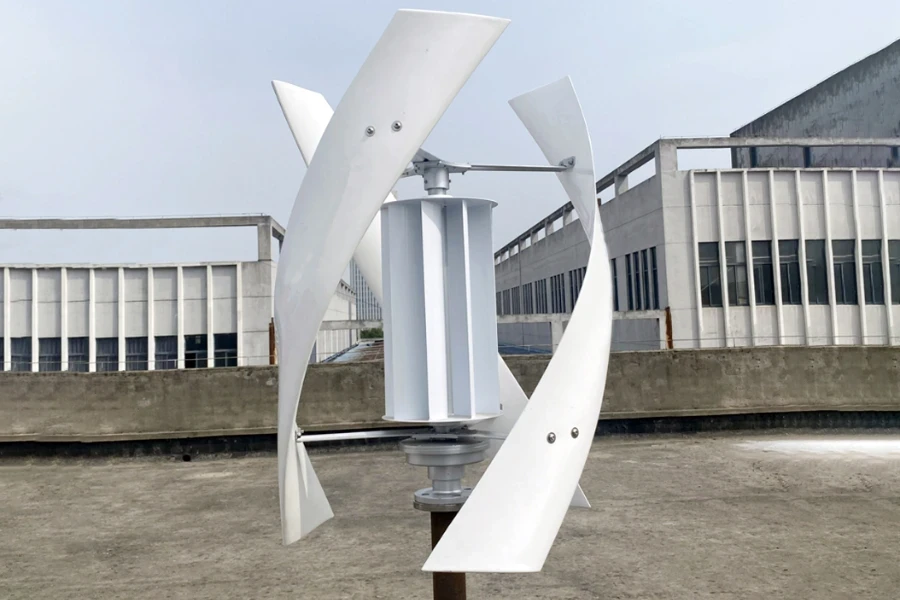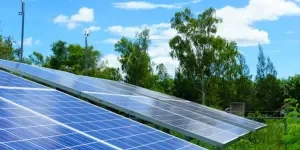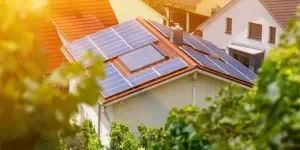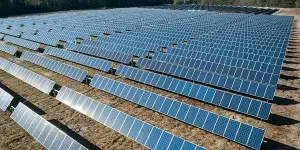As more and more consumers seek out clean, renewable energy for both residential and commercial use, wind energy has become one of the world’s fastest-growing energy sources. At the center of this phenomenon are wind turbines, which are used for wind power generation.
If you’re looking to add wind turbines, also known as wind power generators, it is important to consider a number of factors, including site location, power output, and wind speed.
In this article, we’ll go over how wind turbines work, analyze the global wind turbine market, explore the wind turbine types available, and finally, go over some key factors you should consider when selecting wind turbines to add to your product catalog.
Table of Contents
How do wind turbines work?
Overview of the global wind turbine market
What types of wind turbines are available?
6 factors to consider when selecting a wind turbine
Put wind in your business’s sails
How do wind turbines work?
Wind turbines are tall tower posts equipped with propeller-like blades that are compelled by a rotor, which spins a wind generator that then produces electrical energy. The rotor is driven by an aerodynamic force that is similar to that found in airplane wings or helicopter rotor blades.
As wind flows across the rotor blades, air pressure decreases on one side of the blade, and this difference in air pressure found across the two sides of the blades is what creates the lift and drag effect necessary to cause the spinning and, in turn, wind power generation.
The result of these operations by wind turbines is the generation of electricity, which is referred to as either “wind power” or “wind energy.”
Overview of the global wind turbine market
According to a report by Grand View Research, the global wind power market had a value of US$ 99.28 billion in 2021. The report projects that over the 2022–2030 forecast period, the market value will grow at a compound annual growth rate (CAGR) of 6.5%.
This expected growth is being driven by the increasing global demand to replace conventional energy sources with ones that are cleaner and more sustainable. While solar and wind energy were considered expensive some years ago, technological advancements within the sectors have brought innovative solutions that have set up both wind and solar energy as cost-effective options in comparison to newly built coal and gas today.
Favorable regulatory frameworks and policy structures across many countries and regions, along with global initiatives combating climate change, such as the Paris Agreement, have also propelled growth in the wind power market. This has been particularly true within both the United States and China, which both saw the largest online installation globally. Together, these two markets accounted for 60% of all new onshore additions.
In terms of regional segmentation, it is projected that Asia-Pacific will continue to be the largest onshore and offshore wind power market.
What types of wind turbines are available?
There are three major types of wind turbines that are currently available on the market. Below is a brief overview of each:
Horizontal-axis wind turbines (HAWTs)
These are the turbines many people picture when the term “wind turbine” is brought up. Horizontal-axis wind turbines typically have three blades around a rotor that spin “upwind” on a horizontal axis, that is, facing the direction of the wind.
These turbines are usually mounted on tall towers and are able to capture higher wind speeds while also avoiding turbulence from the ground. The drawbacks, however, are that these turbines have higher installation and maintenance costs, cause greater noise and visual pollution, and pose potential harm to birds and bats.
Vertical-axis wind turbines (VAWTs)
As the name suggests, instead of spinning around a horizontal axis, VAWTs are powered by a rotor and blades that spin around on a vertical axis. Unlike HAWTs, VAWTs can be installed closer to the ground, which leads to easier and cheaper installation and maintenance.
They also have less noise and visual impact and pose lower potential harm to birds and other animals. These turbines are best suited for small-scale applications or urban environments. That said, there are some disadvantages, and these include lower power output and efficiency, challenges around starting and braking, and higher stress being exerted on the rotors.
Hybrid wind turbines
This type of wind turbine may not have a fancy acronym like HAWTs and VAWTs, but they combine the features of both horizontal-axis and vertical-axis wind turbines to optimize performance and the reliability of their wind generation.
Some hybrid wind turbines are actually equipped with both horizontal-axis and vertical-axis rotors, allowing them to get the best of both worlds—capturing both high and low wind speeds. Other hybrid wind turbines are able to counteract the lower power output of VAWTs by pairing vertical-axis rotors with shrouds or diffusers, which help to increase the wind speed and the pressure applied to the blades.
They are not without their challenges, however, as they have higher complexity and greater weight, which lead to lower scalability and limited R&D.
6 factors to consider when selecting a wind turbine
Now that we have a good grasp of how wind turbines operate and the different types of wind turbines available on the market, it is time to explore the top factors that businesses should consider when they want to add wind turbines to their product offerings.
1. Wind source and wind speeds
One of the first things that should be considered by sellers is the wind resource available at the target user’s site. This means being aware of the average wind speeds and direction, as well as the variability over a period of time in the target areas where users will be deploying the wind turbines.
There are online tools that can be used for this purpose, including the Global Wind Atlas, which helps you get estimates of the wind potential in different areas. Another way to assess these wind properties is to install an anemometer at the sites, which is a device that measures wind speed and direction.
Finding out the wind resource will help to determine the wind turbine type, size, and number that will be installed at the site, along with projections of the energy output and the return on investment to be expected.
2. Wind turbine type

With an idea of the wind resources that users will have available at their sites, the next step will be to consider the type of wind turbine that will be installed. As mentioned before, there are three main types of wind turbines: horizontal-axis wind turbines, vertical-axis wind turbines, and hybrid wind turbines.
HAWTs typically have higher power outputs because of their taller installations, which allow them to capture wind at higher wind speeds and avoid ground turbulence. However, while they are considered to be more efficient and reliable, they also usually require more space and greater maintenance to operate.
VAWTs, which are installed closer to the ground, are more compact and offer quieter and cheaper operation, with the downsides being lower efficiency and power output.
The selection of which wind turbine type to use should be based on the power output requirements of the users as well as location considerations, such as whether or not the turbines will be installed in urban environments with less space and stricter noise and visual pollution regulations or in rural environments with more space and a greater allowance for noisier operations.
3. Wind turbine size

From there, you should consider the size of the wind turbine to be used. The size of the turbine is, of course, determined by the power needs of the users as well as their budgetary and site constraints.
Wind turbines have three main categories that are classified based on their rated power output: small (less than 100 kW), medium (100–1,000 kW), and large (more than 1,000 kW).
Small wind turbines are best suited for installations in residential or off-grid environments, as their power output can typically cover the electricity needs of a single home or small community. Mid-size wind turbines are ideal for commercial or industrial applications, as they are capable of supplying enough power for large buildings and small electrical grids. Large wind turbines are the most powerful turbines, meant for utility-scale and grid-connected applications that can feed regional or national grids.
4. Performance and functionality
The next set of factors to consider are the wind turbine options available in terms of technical specifications and performance, and how they compare against the cost. Good resources to use for this analysis are wind turbine catalogs and wind power databases, as they help you find and compare different turbine models and brands that match the target user’s criteria.
Some key parameters to consider include the following:
- Cut-in wind speed: The minimum wind speed needed to start the turbine.
- Cut-out wind speed: The maximum wind speed the wind turbine can withstand.
- Rated wind speed: The wind speed at which the turbine generates its maximum output power.
- Rotor diameter: The length of the blade.
- Hub height: Distance between the ground and the center of the rotor.
- Levelized cost of energy (LCOE): The average cost of producing a kWh of electricity over the turbine’s lifetime.
5. Environmental impact
This step is crucial to consider as it helps users deploy wind turbine operations that are actually in line with the eco-friendly ideals that the renewable energy movement attempts to advance. As some wind turbines can actually have negative effects on their environment, such as noise and visual pollution, harm to birds and wildlife, and increased land use, it is important to measure the environmental impact that certain turbine types or sizes will have on the environment.
Online tools, like the Wind Energy Environmental Impact Calculator, can be used to better estimate the environmental impact of certain wind turbines or projects and offer comparisons with other energy sources so the most eco-friendly solutions can be selected.
6. Permits and approvals
Wind turbine installations are massive operations that require local authority approval to be deployed. There is no use finding a turbine with the most optimal size and power output only to discover that that turbine is not allowed in the intended installation area.
This is why it is important to ensure that research is done on the wind turbine regulations of the target locations. From there, users can then apply for the permits and approvals required to install and operate their wind turbines.
Permits and approvals are typically sought from local planning departments, utility companies, building departments, environmental agencies, and aviation agencies. These parties will then stipulate the various zoning ordinances, noise ordinances, building codes, electrical codes, and safety standards that users will have to comply with. There are professional wind energy consultants available who can offer guidance during this process.
Put wind in your business’s sails
The wind energy sector is sailing along on a course projected to see growth over the coming years. To take advantage of this, energy equipment retailers should add wind turbines to their inventories, as they will see increased demand over the 2022–2030 period.
To know which wind turbines to add to your product catalog, you should take into account factors such as wind source, wind turbine performance parameters, and potential environmental impact. For a selection of wind turbine suppliers to choose from, visit Alibaba.com to explore the extensive product range.



